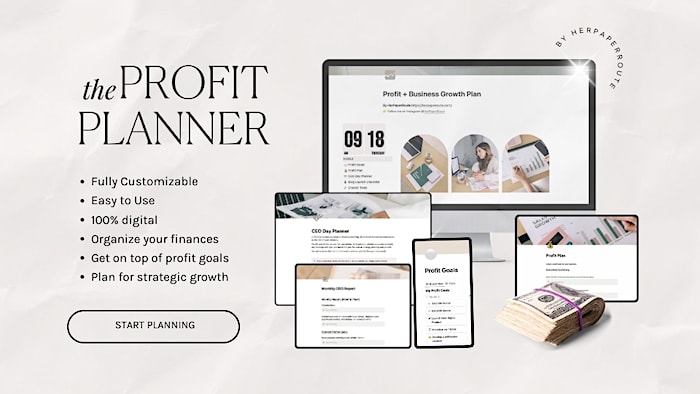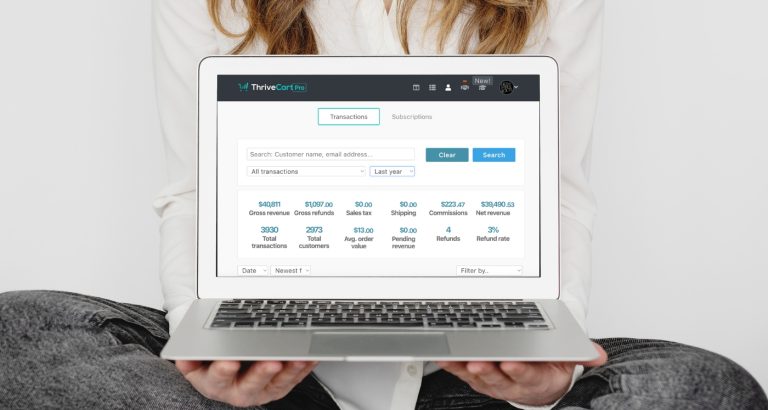How To Nail Your Online Course Pricing With Confidence

Online course pricing can be a little bit tricky. But there are some simple ways to set pricing that makes you feel great and generate the results you’re looking for!
Almost everyone struggles with choosing prices for their online courses, especially when just getting started. Once you fully understand all things online course pricing, though, you’ll feel confident and maybe even enjoy the process!
As an affiliate partner of various brands and sponsored content, HerPaperRoute may earn commission on qualifying purchases. Disclaimer
No matter if you’re brand-new to courses or a pro looking for more strategic pricing tips, I’m here to support you. There’s always room to learn and improve your online course pricing strategy!
6 Online Course Pricing Golden Rules To Follow

Before we dive in and explore the things you should actually factor into your pricing, you need to have the right mindset surrounding your prices.
Here are six things to know about online course pricing—you don’t want to set prices without knowing these golden rules!
1. Online Course Pricing Is Both An Art and A Science
Pricing your online course is both an art and a science. You’ll need to blend together a strategy and your intuition.
Here’s the thing: there is no one mathematical formula that lets you calculate your perfect price. But there does need to be a strategy behind the pricing decisions you make.
On the other hand, you need to follow your intuition and feel good about the price that you choose. Otherwise, it may be a struggle to actually sell your course confidently!
That’s why having a blend of both is so important.
2. Consider The Ripple Effect Your Course Will Create
When you’re trying to figure out your online course pricing, you need to consider the wide-reaching impact (what I call the ripple effect!) that your course will create. After all, your course won’t just impact your students. Instead, it will impact their children, families, communities, or even a global community!
That’s right—one course can impact hundreds of people (or more).
Regardless of your niche, any course you create is going to have some sort of widespread impact and ripple effect. You should approach your online course pricing with the ripple effect mindset to build confidence and know your true value.
Related: The Ultimate Guide To Creating Your First Wildly Profitable Online Course
3. Know That Your Prices Will Likely Increase Over Time
Another thing to keep in mind is that your online course pricing will likely change (a.k.a increase!) over time.
Don’t be afraid to start with a price point that makes you feel comfortable. You can always increase that price later on!
Remember, you’re completely in control of your online course pricing strategy. At any point, you’re allowed to bump your prices up.
You’re going to find that as your confidence increases, and you see students experiencing amazing results, you’re going to naturally feel drawn to boosting your prices.
Even better, as you develop a reputation as an expert in your niche, you’re going to be able to charge more.
4. Be Confident In Your Online Course Pricing
This golden rule might be the most important. You absolutely need to feel 100% confident in your price once you set it. Confident energy is what allows you to persuade people that your course is worth investing in.
Of course, you should step out of your comfort zone a little bit when it comes to online course pricing. But more importantly, you need to feel confident. It really is the most important thing!
5. Don’t Undercut The Market
Sometimes, when struggling with pricing, people conduct some market research, find an average course price, and then charge way less. Do NOT do this!
This type of strategy, called undercutting the market, is a game where no one ever wins.
If your price is way lower than the average, your potential customers will undervalue your course.
A course that’s dramatically underpriced is not going to entice your ideal customer…instead, it will scare them away.
6. Implement Payment Plans To Reduce Entry Barriers
My final golden rule for online course pricing is to implement payment plans. This helps you reduce the barrier for people to enter your course.
Especially if you’re considering a premium price tag for your course (which depends on your audience, the topic, and your expertise), payment plans matter.
When you create a payment plan, you don’t hurt yourself at all, but you do open the door for so many more people to invest in your course.
I recommend creating one payment plan option aside from paying in full. Too many payment plans can actually cause your potential students to experience decision fatigue and not convert.
7 Things To Consider When Deciding On Your Online Course Pricing
Now that you know my most important golden rules for online course pricing, how do you actually figure out your prices? Don’t worry! I’ve got seven factors for you to weigh when considering your prices.
With these seven factors in mind, you’ll be able to build the perfect price for you, your audience, and your niche.
Market Pricing
First, do some market research. Look at other courses in your area of expertise or niche.
This doesn’t mean you need to set your prices exactly the same, but you likely won’t want to be the highest- or lowest-priced course, either.
Established, go-to experts are the ones with the highest-priced courses.
And someday, that might be you! But when you’re first getting started, you’ll want to fall somewhere in the middle range of typical online courses for your niche.
This isn’t the most important factor, but it is worth considering.
Your Ideal Student
Once you’ve done some market research, hone in on your ideal student.
Who do you want to attract and teach inside your course? Who is that person and what is their budget like?
Most importantly, how aware is this person of the problem that your course solves, and how motivated are they to make a change, achieve results, or solve that problem?
Knowing your ideal student inside and out helps you clarify your online course pricing. Remember, everything in your course is for that person!
Your Expertise and Experience
You should also consider your own expertise and experience in your niche.
This can be lots of things, including:
-
Educational background
-
Industry credentials
-
Years in business
-
Results you’ve generated
These things matter, but there’s also something super important you need to know:
You don’t have to be the number one expert in your niche in order to create a super successful online course. You just need to have at least some expertise and experience.
Consider basing your online course pricing partially on your level of expertise, experience, and helping others achieve a certain result.
Now, if you are a top expert in your niche, you should charge a premium price right off the bat.
The Amount of Time and Level Of Support You’ll Provide
Next up, consider the amount of time and the level of support you plan to give your online course students. Is your course totally self-paced with no student community? Or do you offer support and community mentorship?
The more time you’ll spend supporting students, the more you can charge for your online course.
Related: 5 Types Of Bonuses That Will Help You Sell Online Courses
The Quality Of Your Course Content
This might sound obvious, but it’s really important. You’ll want to evaluate the quality of your course content (notice—quality, not quantity!). The size of your online course doesn’t matter. More modules and lessons do not equate to a bigger price tag.
Instead, the quality of your content is what matters most. You need to price your online course according to the quality of the content inside.
And if you’re just getting started, you can always bump up your prices later as the quality of your course improves.
The Caliber Of Student You’re Hoping To Attract
Another thing to consider is the caliber of students that you want to attract to your course.
Generally, a higher price tag leads to more committed students who are willing to devote time and effort to implement the strategies you teach,
Those types of students will likely experience results and be willing to create testimonials and give referrals to you. This helps build the hype around your course and ultimately make more sales!
All of this is to say that sometimes, a higher price tag really does pay off in the long run.
The Rest Of Your Product Suite
The final factor to consider in your online course pricing is the rest of your product suite.
What else do you offer, and how does this particular course fit into your customer’s journey with your business?
There needs to be cohesion and layering to truly keep your audience invested long-term.
How To Nail Your Online Course Pricing With Confidence – Conclusion
Online course pricing might seem overwhelming at first. But take the time to consider each of these factors, and build confidence in your pricing!
Remember that you can always change your prices later, and it’s most important to choose prices that feel good to you.
Ready to create your profitable online course this weekend? Then make sure you grab your free copy of our Course Creation Roadmap!

Follow along on Instagram!













